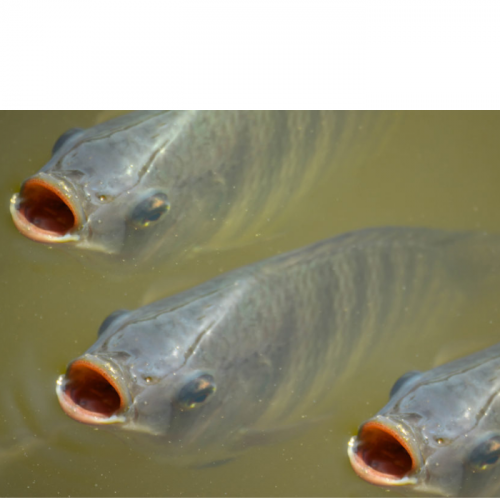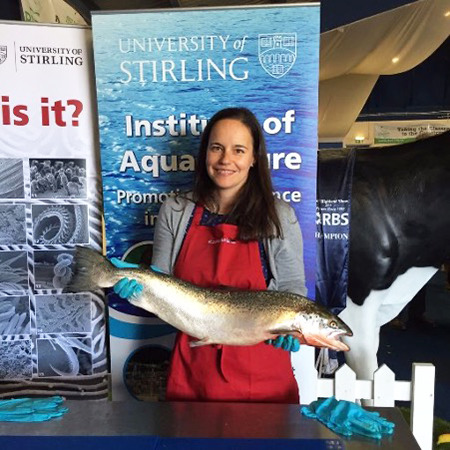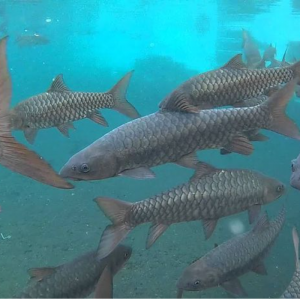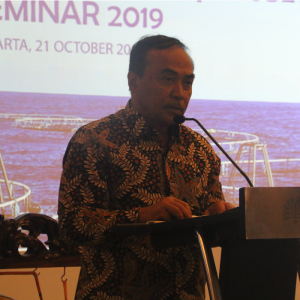
Fish nutrition Will Fuel Aquaculture’s Future
| Tue, 09 Feb 2021 - 12:29
Can nutrition help to improve sustainable aquaculture, is one of the questions being researched by Dr. Monica Betancor, a lecturer at the University of Stirling in Scotland, who works as part of an international nutrition research group.
“Fish nutrition and fish health are intrinsically linked, and nutrition also impacts on the end products eaten by consumers,” she said during a recent webinar session organised by the Women in Scottish Aquaculture group.
Betancor explained that by 2050, the demand for animal protein is predicted to almost double, with marine-based proteins making a more significant contribution to consumer diets. As the most efficient form of animal production, aquaculture is a natural fit to meet this need. The current estimated amount of feed required to gain one kilogram of body mass in different animals is 1.1 kilograms for farmed fish, 1.7 kilos for chicken, 2.9 kilos for pigs and 6.8 kilos for cows.
“But if aquaculture production is to fulfill its potential, greater investment needs to be made in sustainable feeds, which implies the use of resources at rates that do not exceed the capacity of the Earth to replace them,” she said.

Monica Betancor, University of Stirling.
Using Norway as an example, she explained that considerable advances have been seen in fish feed since the early 1990s, when up to 90 percent of the composition of salmon feed was marine protein and marine oil, with the remainder being starch.
Since then, as salmon farming has advanced, the proportion of marine protein has fallen to less than 20 percent and marine oil to around 5 percent, with the remainder made up of increasing percentages of plant proteins, plant oil and micro-ingredients. The proportion of starch has remained roughly constant.
“Replacing marine sources with vegetable proteins may sound good, but it does not necessarily help us move towards a zero carbon footprint and may contribute to deforestation,” Betancor said. “When considering the carbon footprint of feed, terrestrial ingredients such as soybean or palm kernel meal, which have to be transported across the world, have a far higher carbon footprint than locally sourced poultry meal or mixed rendered animal byproduct meal.”
Problems with PAPs
However, alternatives come with issues. Animal byproducts such as meat and bone meal, processed animal proteins, blood meal, poultry meal and feather meal, are high in protein, cheap and contribute towards a zero-waste solution. But they suffer from poor public perception, a lack of omega-3 fatty acids found in oily fish, and are limited by legislation, particularly in the European Union (EU). Here, fish cannot be fed processed animal proteins derived from ruminants (sheep, cows), which are considered to be high risk, although poultry- and swine-derived products may be used.
One of the biggest barriers to use of products of animal origin (PAP) in the EU, is consumer and retailer perception. A short poll by the University of Stirling found that while feed companies are happy to use PAP in their feeds and UK consumers would support its use if it led to cheaper salmon, retailers were not keen to risk the potential for bad publicity.
“Elsewhere in the world, in Chile for example, it is common to include PAP in salmon feed, and this cheaper fish ends up on UK supermarket shelves, so why not sanction its use here?” Betancor said.
According to the World Renderers Organisation, animal byproducts are widely available, with more than 12 million metric tons (MT) processed annually.
Other menu items
To make aquaculture more sustainable, Betancor has been researching the use of alternative protein and lipid sources that either boost or maintain omega-3 levels, which are essential both to fish and human health. She is also working on several projects to see if fish can make better use of nutrients.
Alternatives currently commercially available are insect meals, microbial or single cell proteins, and microalgae. Insect meal can be locally produced, grown on feed-grade substrates and have a short lifecycle. Seven species are currently approved for use as in feeds, including mealworms, crickets and black soldier flies.
“Insects have a reasonably positive public perception and one French supermarket actively promotes its own-label insect-fed trout,” Betancor said.
If aquaculture production is to fulfill its potential, greater investment needs to be made in sustainable feeds.
Scalability is currently a limiting factor, along with the high chitin content of insects, which can impact digestibility. However, Betancor explained that a short project she was involved in examined the benefits of using insect meal as a probiotic functional ingredient by fermenting it with different microbes to improve digestibility.
“By including just 5 percent of the resulting product in feed, the protein content of Atlantic salmon parr in the trial was increased, and their immune status improved,” she said.
In October 2020, a new project called ‘ilnsect’ was set up to establish the UK as a world-leading centre of excellence for highly automated, low-cost black soldier fly farming technology.
“The aim is to demonstrate the UK’s first industrial-scale insect bioreactor that will recycle food waste into live larvae and frass, and prove the viability of the meal in aquafeed through commercial salmon trials,” Betancor said.
Microbial meals, made from single-cell proteins, can be derived from bacteria, yeast or microalgae, and the two main players in this field are FeedKind which produces Calysta, and Deep Branch, which produces Proton. Microbial sources score highly on protein and omega-3 content, but are not yet scalable to the level needed, and have low digestibility.
Potential sources of single-cell protein products
A new £3 million-plus project, REACT-FIRST, is investigating the commercial-scale viability of transforming carbon dioxide from industrial emissions into animal feed, and will gather data about the cost, digestibility, nutritional quality and carbon footprint of Proton. Partners from across the supply chain will enable a full analysis through to market deployment via a major retailer.
Microalgae are primary producers of the fatty acids EPA + DHA in the aquatic environment and are used in several different microalgae based biomass products.
“AlgaPRIME, DHAgold, DHANatur, Forplus and Nymega are all rich in DHA, but can only be included in fish feed in limited quantities, due to digestibility issues, whereas Veramaris has specialised in algal oil, which has a 1:2 ratio of EPA:DHA,” Betancor said.
Boosting omega-3 levels
The need to improve omega-3 levels in salmon is based around scientific recommendations for human health. The International Society for the Study of Fatty Acids and Lipids (ISSFAL) recommends eating 3.5 grams of EPA+DHA each week. Eicosapentaenoic acid (EPA) and docosahexaenoic acid (DHA), are two essential omega 3 long-chain polyunsaturated fatty acids (LC-PUFA).
In 2006, according to studies by the University of Stirling, one portion of Scottish salmon provided 3.9 grams of EPA+DHA, but by 2016, this had reduced to 1.9 grams of EPA+DHA, as the level of vegetable protein and oil in salmon feed increased.
This has led to a need to identify alternative lipid sources that are high in marine ingredients and low in terrestrial plant ingredients, which can help to boost EPA+DHA levels. Alternatives include copepods, krill, microalgae and genetically modified (GM) organisms.
GM yeast and oilseed crops may be rich in either EPA or DHA alone, or a combination of both, and several commercial products are currently available. Aquaterra/Nuseed and BASF/Cargill use canola plants, and Rothamsted Research in the UK has been undertaking promising trials with Camelina sativa.
The process works by selecting and cloning genes involved in LC-PUFA biosynthesis from marine algae, which are introduced into plants. These in turn, reproduce with their novel fatty acid composition. Only the fatty acid profile of the seed is affected in the transgenic process; all other aspects of the plant remain the same.
According to Betancor, incorporating oil into feed reduces public concern about the transfer of trans genes into fish, but in general, their perception of any GM product is poor in Europe and education is urgently needed about its potential benefits.
“Regulatory barriers also exist, making it illegal to grow GM crops in some countries, and even where they can be grown, many farmers are wary of using them for fear of having their crops destroyed by vigilantes,” she said.
The potential of nutritional programming
An alternative way to boost omega-3 levels in fish, and one which Betancor finds exciting, is using nutritional programming to improve the utilization of sustainable feeds in aquaculture. The process works by giving fish a nutritional stimulus through a diet containing different levels of polyunsaturated fats. This encourages a change in the metabolism of the fish, which in turn helps to improve nutrient utilization.
“One of our current programs, Nutriprog, is looking at the long-term effects of nutritional programming in fish, and how it affects their ability to produce EPA+DHA,” she said.
The first feeding trial used marine and vegetable stimulus diets for two weeks, followed by a marine diet for 12 weeks, before a further six- week period on a vegetable diet. Initial results indicate that fish stimulated with the vegetable diet at an early stage, showed a net gain of EPA+DHA after the six-week challenge, whereas those initially fed with a marine diet, lost DHA+EPA during this time. “These fish have now been put out to sea and it will be interesting to see if the early changes we found will last through the whole growth cycle,” she said.
Source: Global Aquaculture Alliance






















